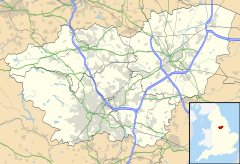Woolley Colliery facts for kids
Quick facts for kids Woolley Colliery
|
|
|---|---|
 Woolley Colliery, pictured in 1979 |
|
| OS grid reference | SE319132 |
| Metropolitan borough |
|
| Metropolitan county | |
| Region | |
| Country | England |
| Sovereign state | United Kingdom |
| Post town | BARNSLEY |
| Postcode district | S75 |
| Dialling code | 01226 |
| Police | South Yorkshire |
| Fire | South Yorkshire |
| Ambulance | Yorkshire |
| EU Parliament | Yorkshire and the Humber |
| UK Parliament |
|
Woolley Colliery is a village in Wakefield district in West Yorkshire, England. The village is near the border with South Yorkshire. The former colliery was in the Wakefield Rural Ward in West Yorkshire. The village is known locally as Mucky Woolley, as a tribute to its coalmining heritage and to distinguish it from the more affluent village of Woolley two miles away.
Coal mines were worked as early as 1850, and at about that time the village was established when two rows of small terrace cottages were built to accommodate miners. There are several coal seam outcrops on the hillside and coal had probably been mined in the area for many years before, but only on a small scale until railway transport began. Woolley Colliery itself was established in 1869. The mine had three shafts, three seams (named Fenton, Lidgett and Thorncliffe), and five coal faces. Woolley Colliery was nationalised in 1947 and the majority of the coal mined there went to the production of electricity and coke. The pit grew to become one of the largest in West Yorkshire. In 1980 it employed 1514 men underground and 428 on the surface.
The colliery began when two tunnels or drifts were dug into the Barnsley bed seam in the hillside. Vertical shafts were sunk to reach the deeper seams. In the 1960s there were three shafts in the pit yard and a fourth, for ventilation, about a mile to the east. At that time around 17,000 tons of high-quality coal were produced each week.
Arthur Scargill, later the leader of the NUM, started work at the colliery in 1953, when he was 15. The pit was among the most conservative in Yorkshire, and Scargill was often in dispute with the branch leadership. He organised a strike in 1960 over the day on which union meetings were held, as he argued that these were deliberately being held at times when the sections of the workforce that were inclined to militancy were unable to attend.
Miner's Strike 1984–85
During the UK miners' strike of 1984–1985 roughly 70 per cent of the workforce at the colliery went on strike for a year, but the NUM branch leadership remained conservative about the use of flying pickets and union funds to help strikers. There were arguments with the lodge at North Gawber Colliery on contributions to a kitchen, as it was claimed that Woolley, which was a much larger pit, was making a minimal contribution to feeding strikers. After the strike the men from North Gawber were transferred to Woolley.
Woolley Grange
The pit was closed in 1987 and the buildings were demolished in 1993. The site is now home to a private housing estate, Woolley Grange. In 2023 further housing development plans on the site of the former colliery were opposed by local residents and ecologists on the grounds that the scheme would erode local identity and have an adverse effect on local wildlife. The proposed construction site covered a natural habitat housing a colony of the small blue butterfly, with the development plans leaving only the SUDS undeveloped.



